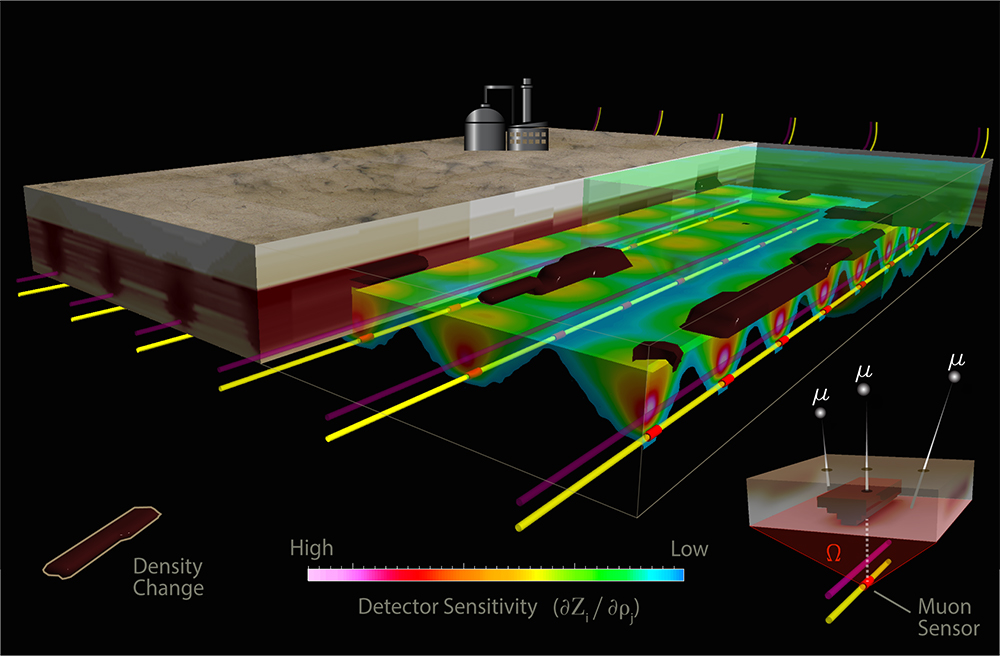New study shows promising results for Canada’s oil sands producers
Vancouver, BC, CANADA (July 21, 2020) – Cosmic rays offer a solution to the longstanding challenge of how to monitor and optimize large-scale steam-assisted gravity drainage (SAGD) operations cost-effectively for the oil and gas industry. Results of a study published this month in The Leading Edge journal (a publication of the Society of Exploration Geophysicists) demonstrate the consistent detectability of SAGD reservoir depletion patterns through cosmic-ray muon tomography. Lower-cost, reliable, continual monitoring of reservoirs using this technology can improve the known efficiencies of SAGD extraction and further reduce environmental impact, helping to position Canadian oil more competitively in volatile global markets.
Muon tomography powers Ideon Technologies’ discovery platform, which integrates proprietary detectors, imaging systems, inversion models, and artificial intelligence to provide x-ray-like visibility beneath the Earth’s surface. Co-led in part by Ideon Technologies CTO Doug Schouten, PhD; Queen’s University graduate student and Ideon research fellow Sara Pieczonka; and Professor Alexander Braun, PGeoph, of the Department of Geological Sciences and Geological Engineering at Queen’s, this new study shows the effectiveness of muon tomography when applied to density models of a SAGD reservoir at 1.25 and 5 years after initial reservoir production.

Canada’s oil sands hold the third largest oil reserves in the world and are a key strategic resource contributing to economic opportunity and energy security for Canada. These reserves are in the form of bitumen mixed with sand, water, and clay. Bitumen does not flow like conventional crude oil, which makes extraction challenging and costly. The SAGD process injects high-temperature steam into underground reservoirs to lower bitumen viscosity, allowing it to flow and be extracted through a producer well. This method significantly improves heavy oil recovery and is more efficient than open-pit extraction and most other thermal recovery methods. Muon tomography can improve these efficiencies even further.
“SAGD operations cover large geographic areas and are monitored regularly to optimize productivity, mitigate environmental risks, and ensure regulatory compliance,” says Schouten. “Current monitoring processes are expensive, periodic, labour-intensive, and disruptive to operations. The Ideon muon tomography platform will provide continuous reservoir surveying for the entire SAGD life cycle with little or no maintenance, at a significantly reduced cost compared to survey campaigns using current monitoring techniques.”
Pieczonka is delivering the study results this week at the Unconventional Resources Technology Conference (URTeC). “The target for our modeling is an active SAGD reservoir in Alberta’s McMurray Formation,” she says. “Our results show that muon tomography can provide important depletion parameters to help operators save energy costs, reduce water consumption and CO2 emissions on short timelines, which may not be achievable using traditional 4D seismic surveying.” Muon data could also be combined with surface gravity, specifically gravity gradiometry, and seismic data to provide a complementary modelling combination.
Pieczonka’s graduate studies supervisor and co-author Prof. Alexander Braun is a renowned geophysicist who has spent years researching advances in using geophysical data from satellite, airborne and terrestrial observation platforms. “By deploying Queen’s research fellows to address real-world challenges with industry, we are advancing the development of creative new solutions using next-generation technology. Muon tomography is currently the most promising and innovative technology in geophysical exploration,” he adds, “and has vast potential to change the way traditional industries operate. Partnering with Ideon to help bring it to market, and seeing the direct impact our students make in that process, is very exciting.”
Ideon will begin commercial release of its compact borehole muon detectors next year but is accepting interested parties into an Early Access Program now.
